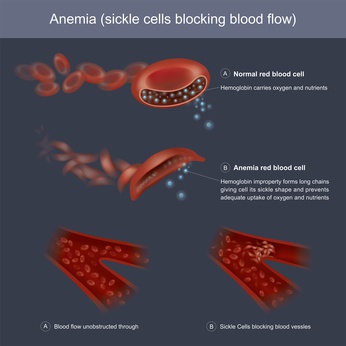
Message
The experience of pain does not minimize who we are, and it provides challenges to relief. It is time to educate healthcare providers, legislators and the public to enable better treatment options, access to care, and acceptance
Facts
Sickle cell disease is a genetic disorder that alters the shape of the red blood cell into a sickle shape. There are two forms of SCD, chronic hemolytic anemia and intermittent vasoconstrictive episodes. SCD is a collection of inherited blood disorders that affects African Americans, people from Central America, South America and the Mediterranean. Approximately 100,000 people have SCD. One out of every 500 African Americans and one out of every 16,300 Hispanic Americans have SCD at birth and 300,000 people are born with SCD worldwide. One out of every thirteen babies are born with the sickle cell trait (CDC, 2018). Many people are born with the sickle cell trait, therefore genetic screening is vital. Since there is no registry for individuals with sickle cell disease, the numbers reported by the CDC are estimates. The average life span of individuals with SCD has increased, however the resources to treat and manage the disease have not matched the increase in life span.
Pathology
The red blood cells obstruct blood flow to multiple body systems, organs and tissues. The decreased blood flow causes pain, inflammation and damage. Complications resulting from Sickle cell crisis include strokes, heart attacks, blood clots, splenic injuries, kidney injury, loss of vision, medullary renal cell carcinoma, malnutrition and stunted growth. Pain results from insufficient blood flow and injury causing damage to organs, tissues and joints.
Treatments, Management & Prevention of Crisis
Treatment and management focus on staying hydrated, infection prevention, vaccinations, and avoiding unhealthy behaviors. Other treatments include anti-inflammatories, blood transfusions, and strong pain medications (opioids). The goal is to minimize a crisis requiring hospitalizations. Additional treatments include stem cell transplants and a medication called L-glutamine.
Crisis (increased pain, injury and damage to body systems, tissues and organs) occurs when patients become dehydrated, develop illnesses or are stressed. To prevent a crisis, situation hydration (giving patients intravenous fluids), blood transfusions, and anti-inflammatories are valid and accepted treatments.
Access to Care
There are very few outpatient centers designed and able to provide treatment and management to decrease hospitalizations, incidence of crisis, and suffering. Many people enter the emergency rooms face the practice of limited perscriptions for opioids for treatment. A number of people have reported that they are not believed when they express the degree of pain and lack of relief.
Much needs to be done regarding increasing access to care, treatment and management. National registries need to be created and developed to provide funding for centers of excellence, accurate numbers of prevalence of the disease.
For more information visit:
